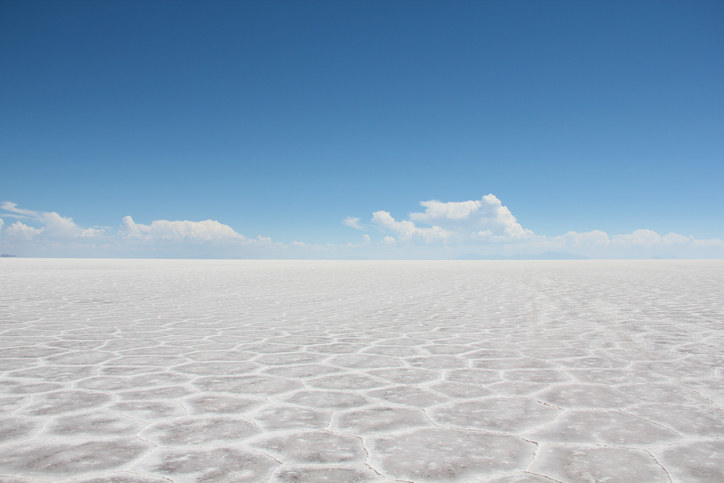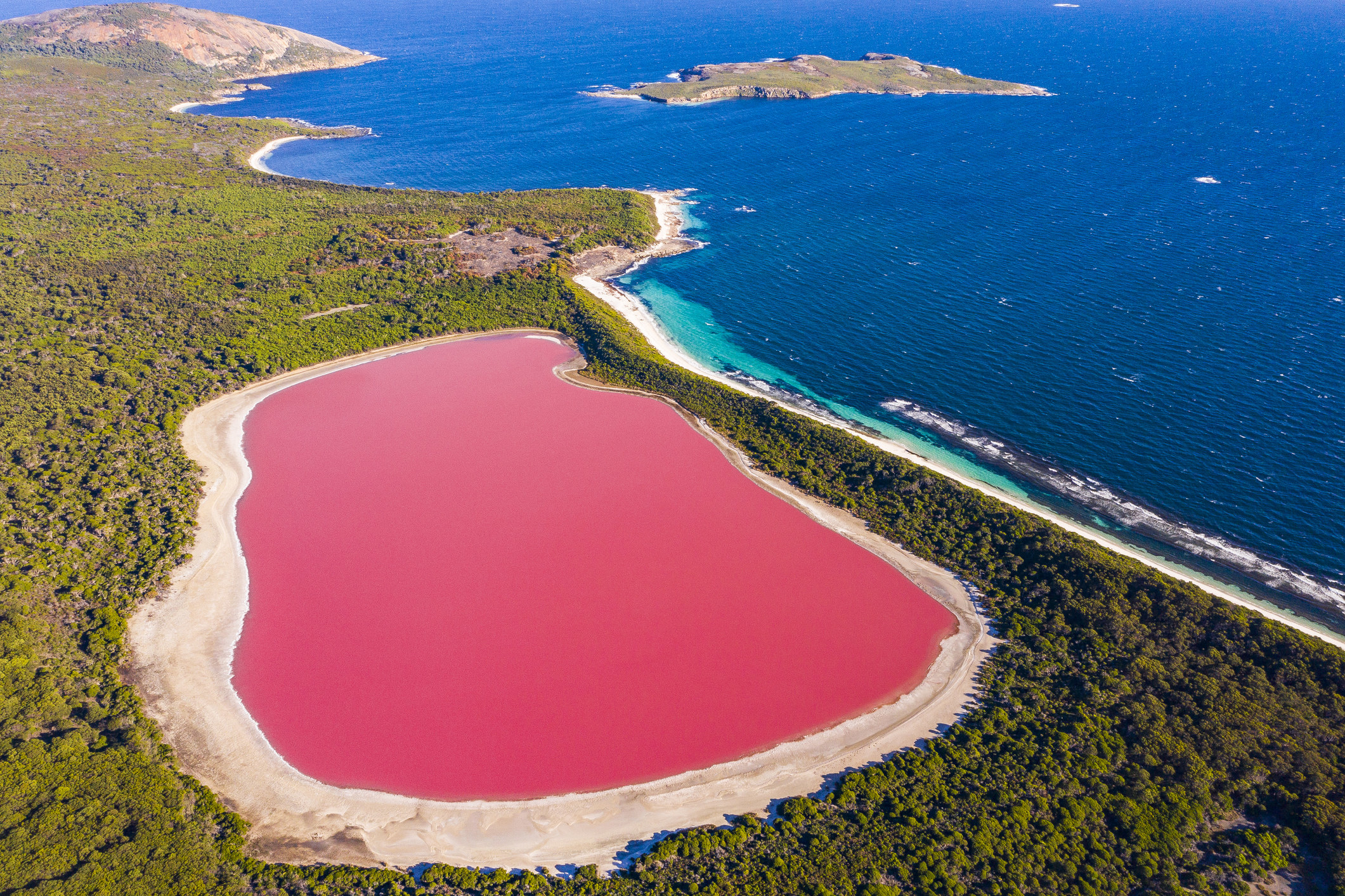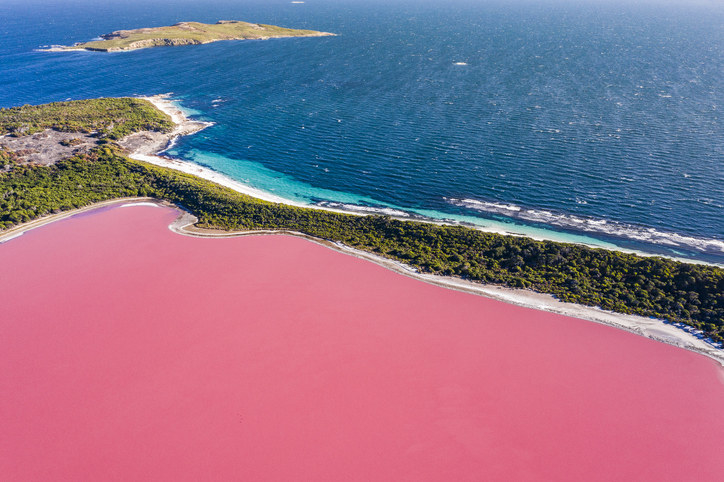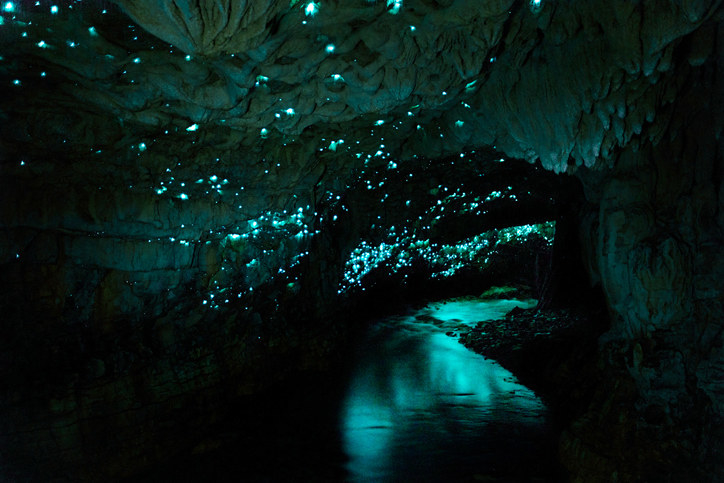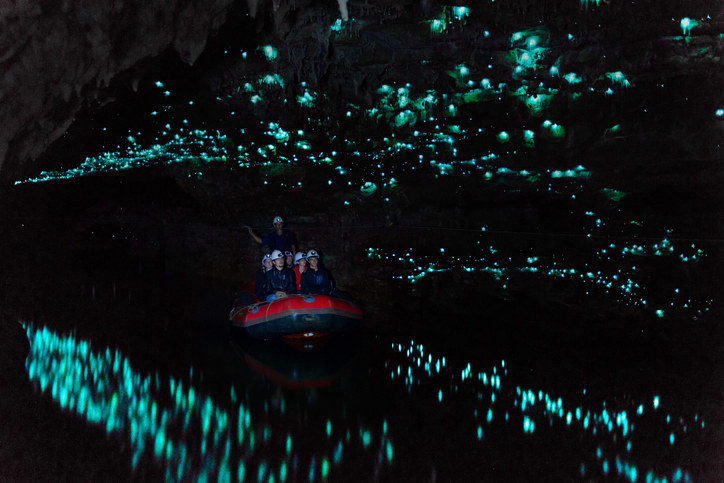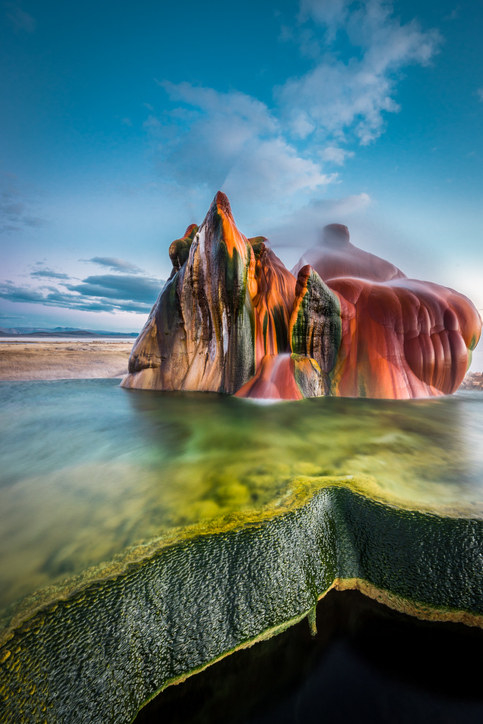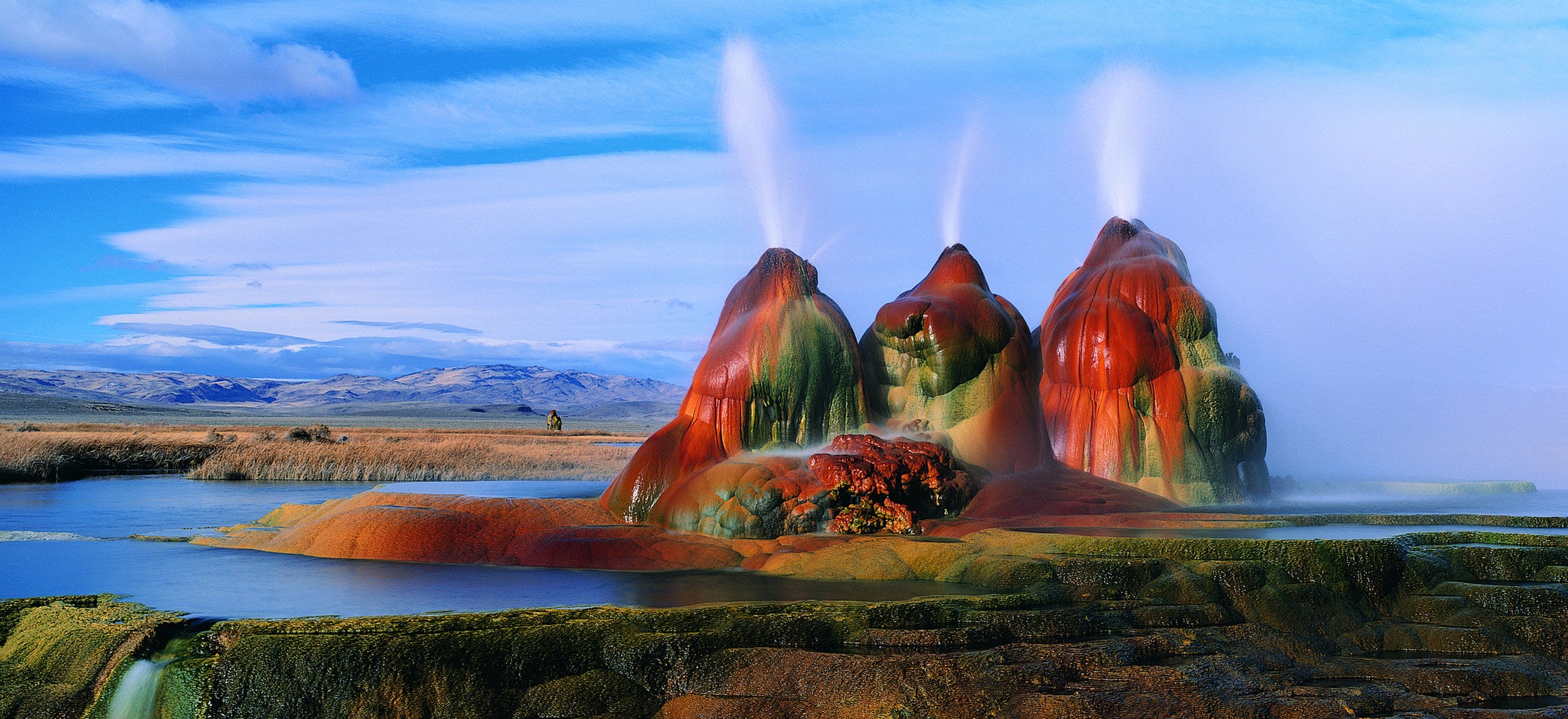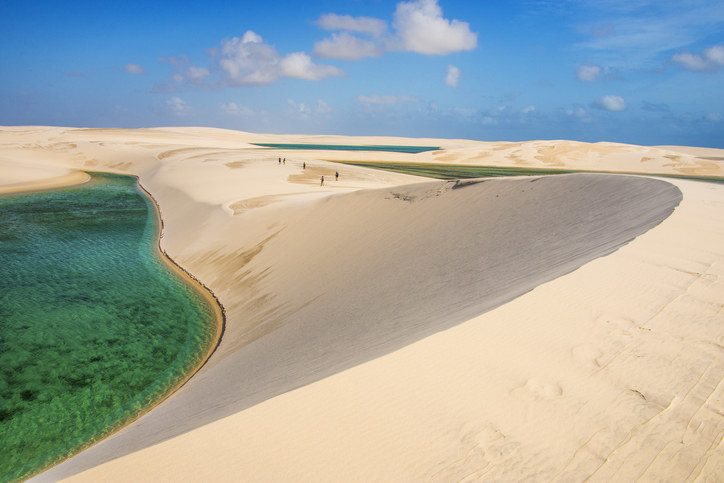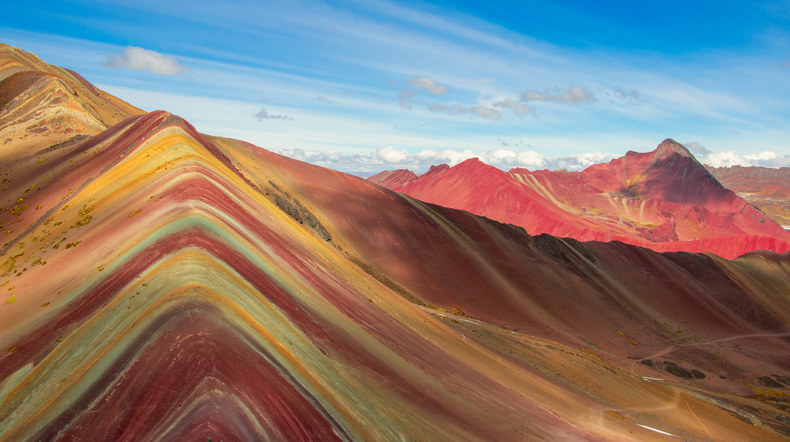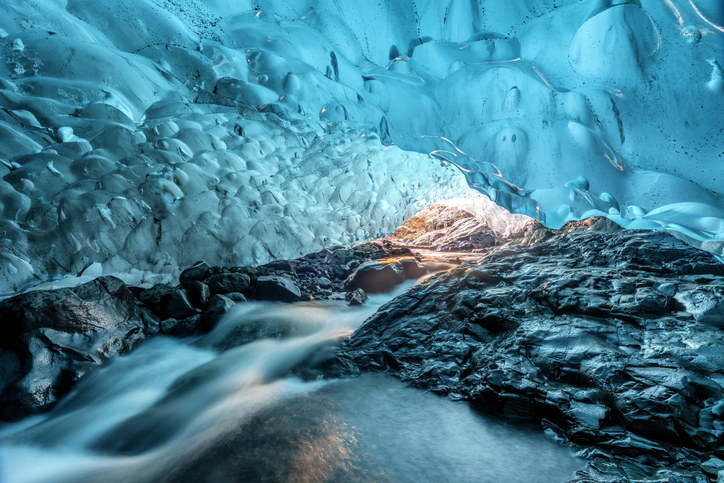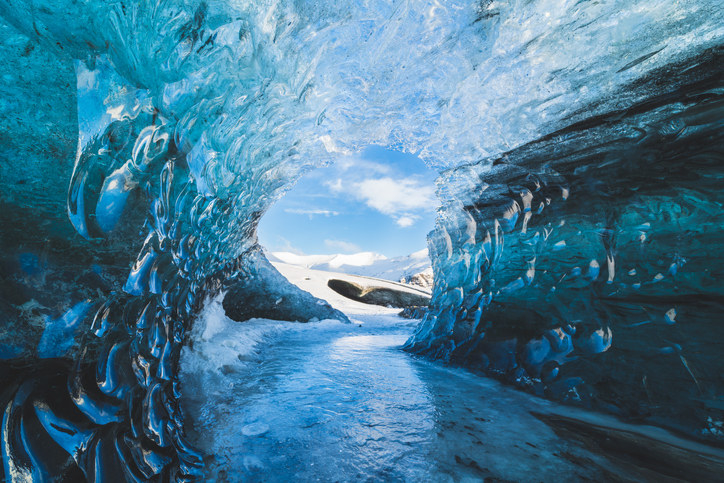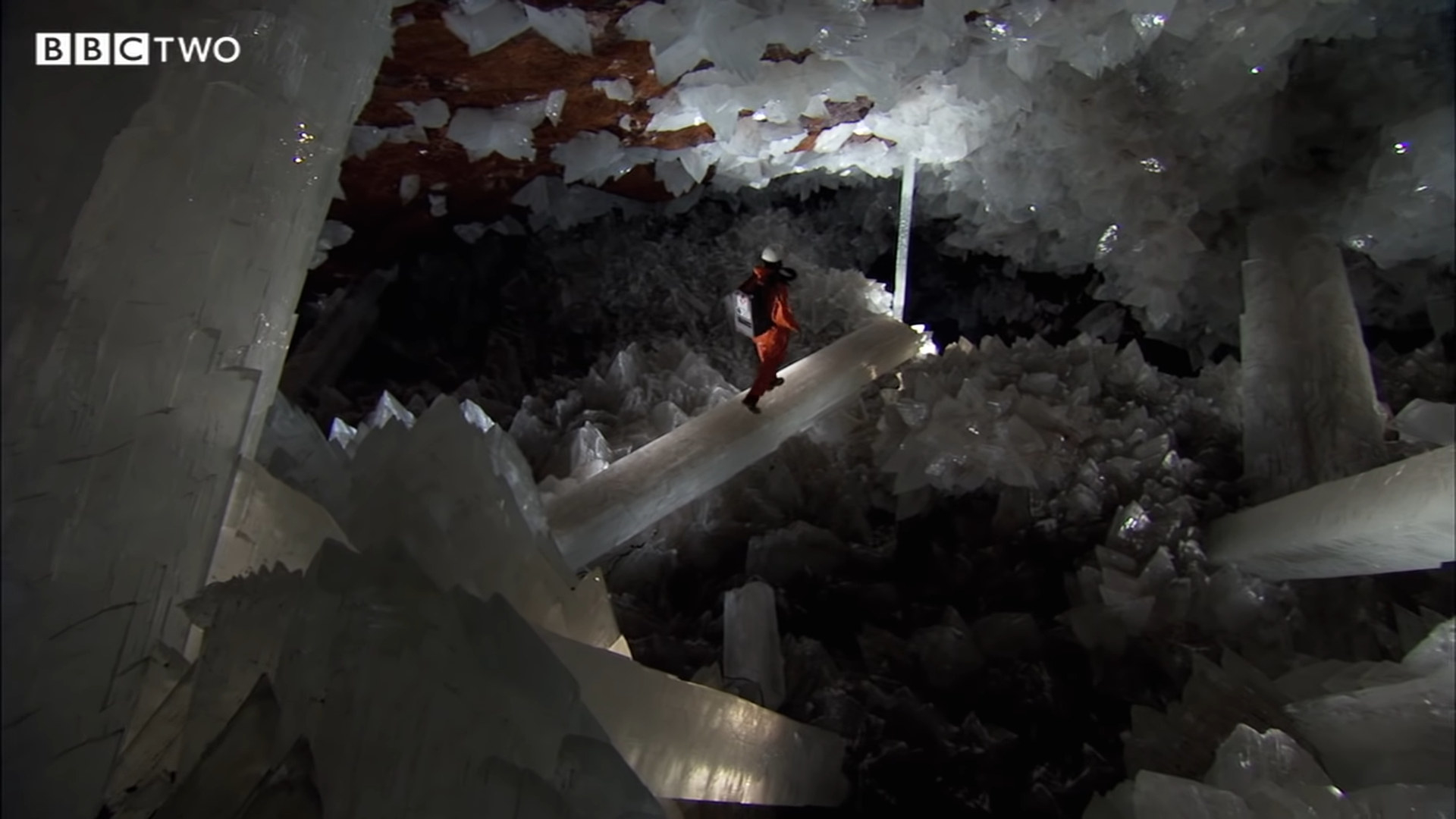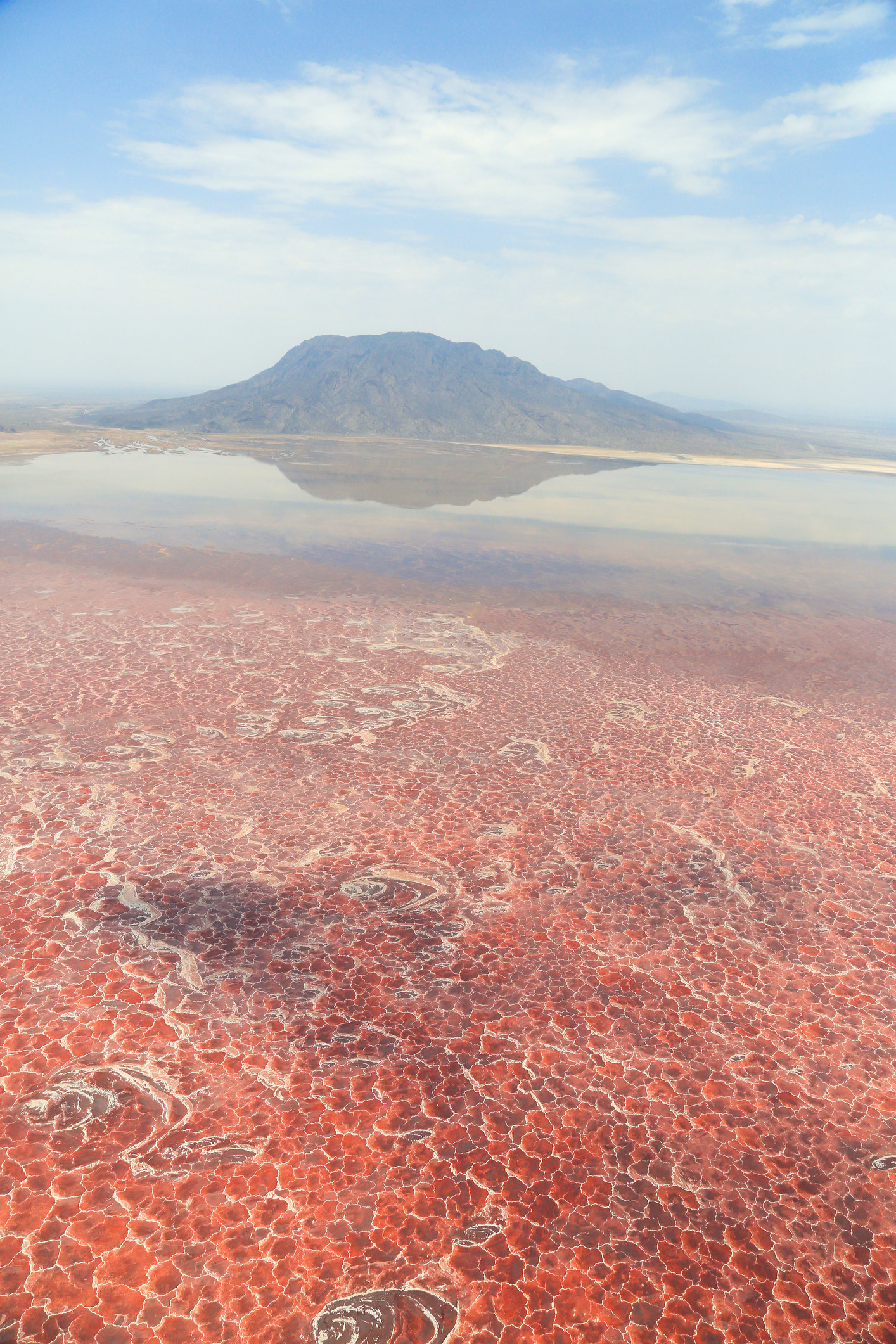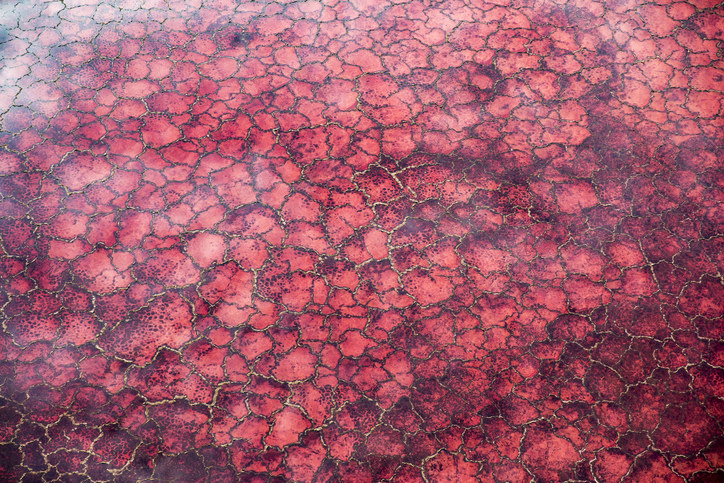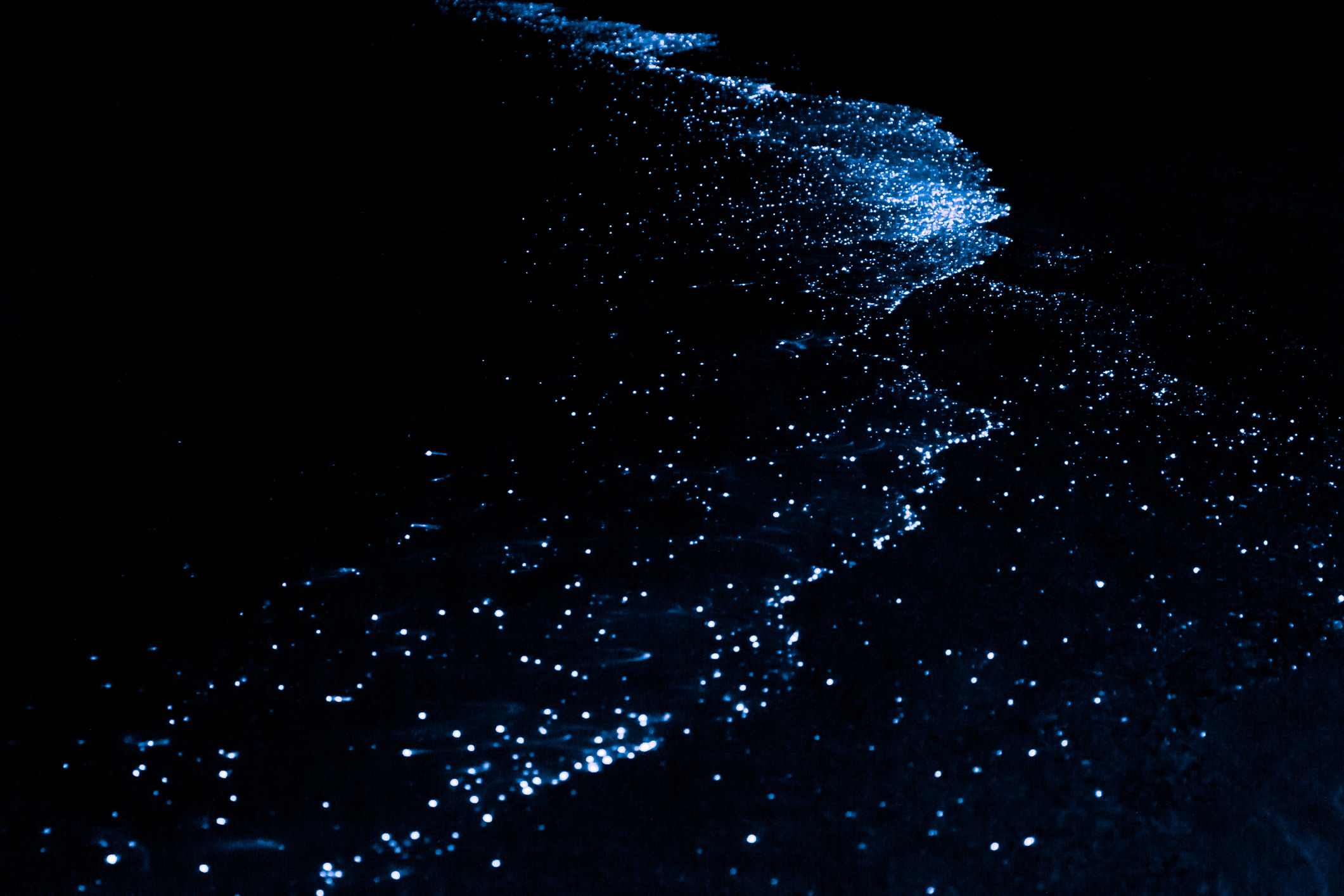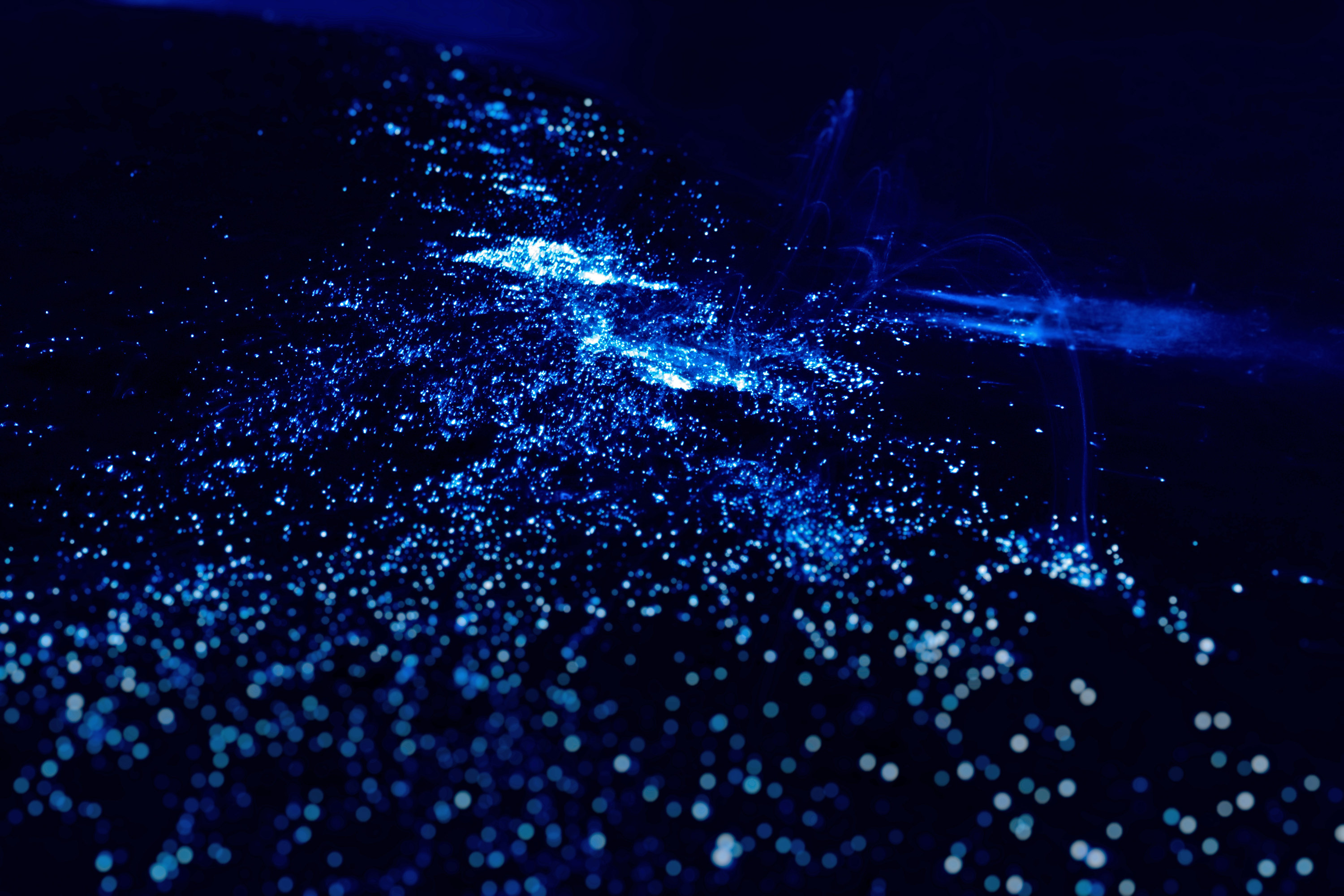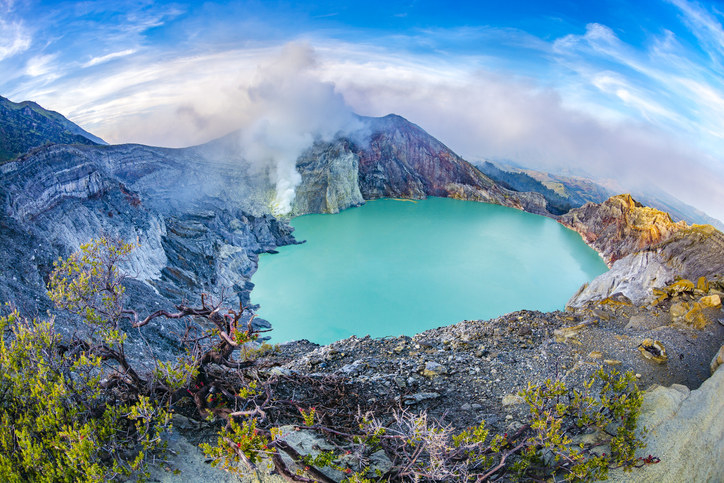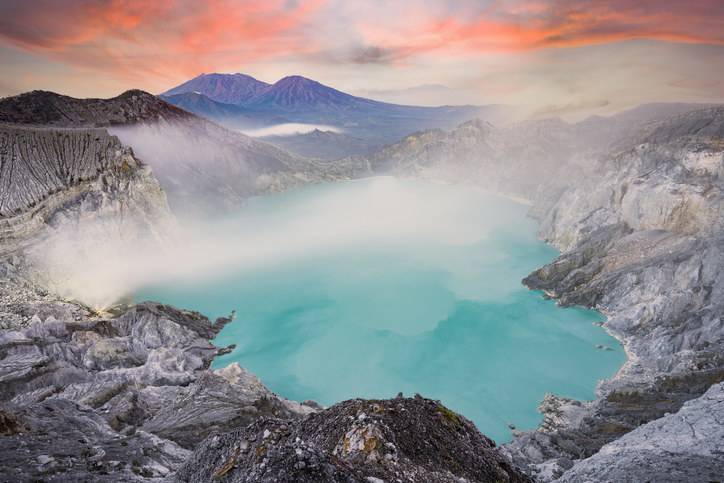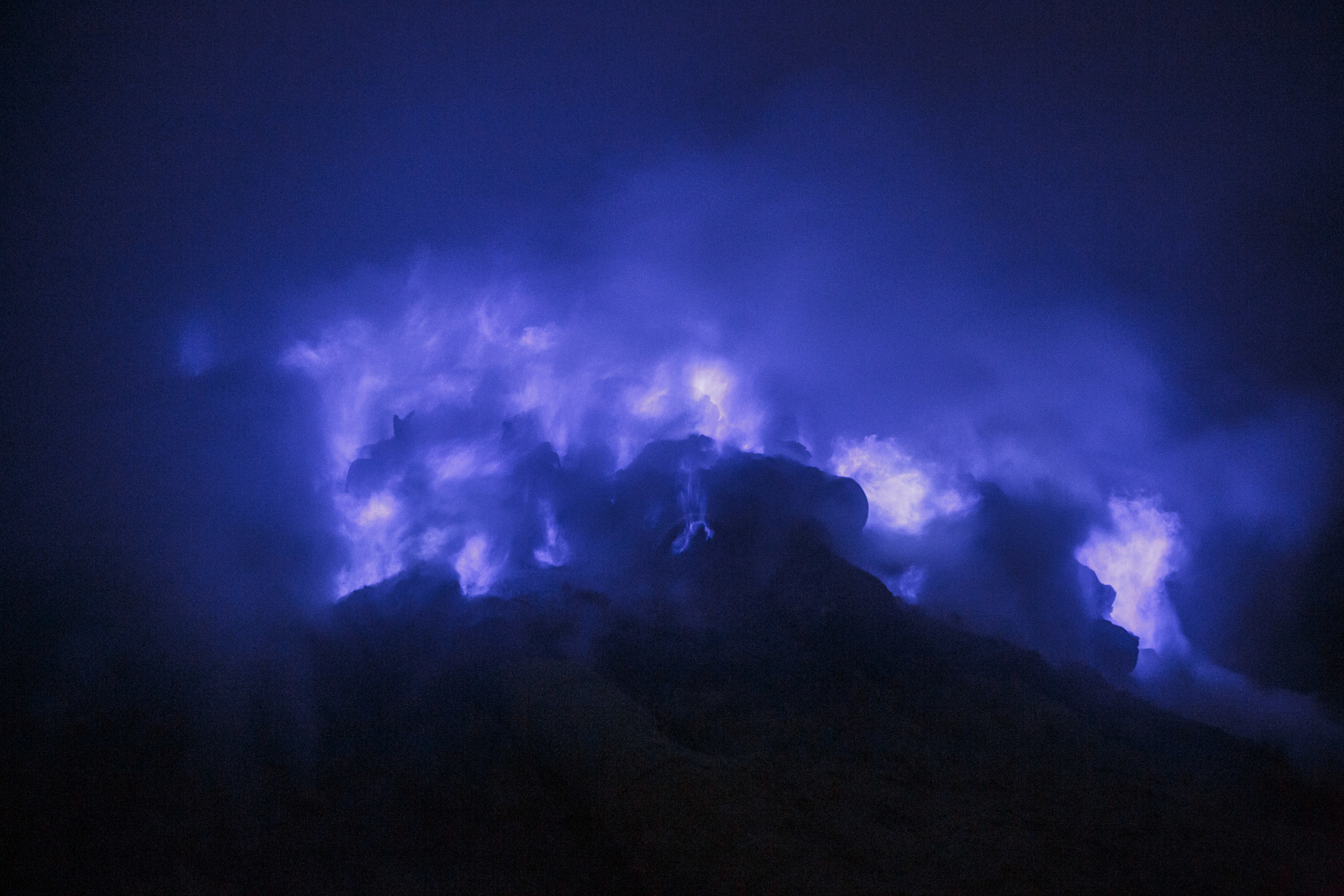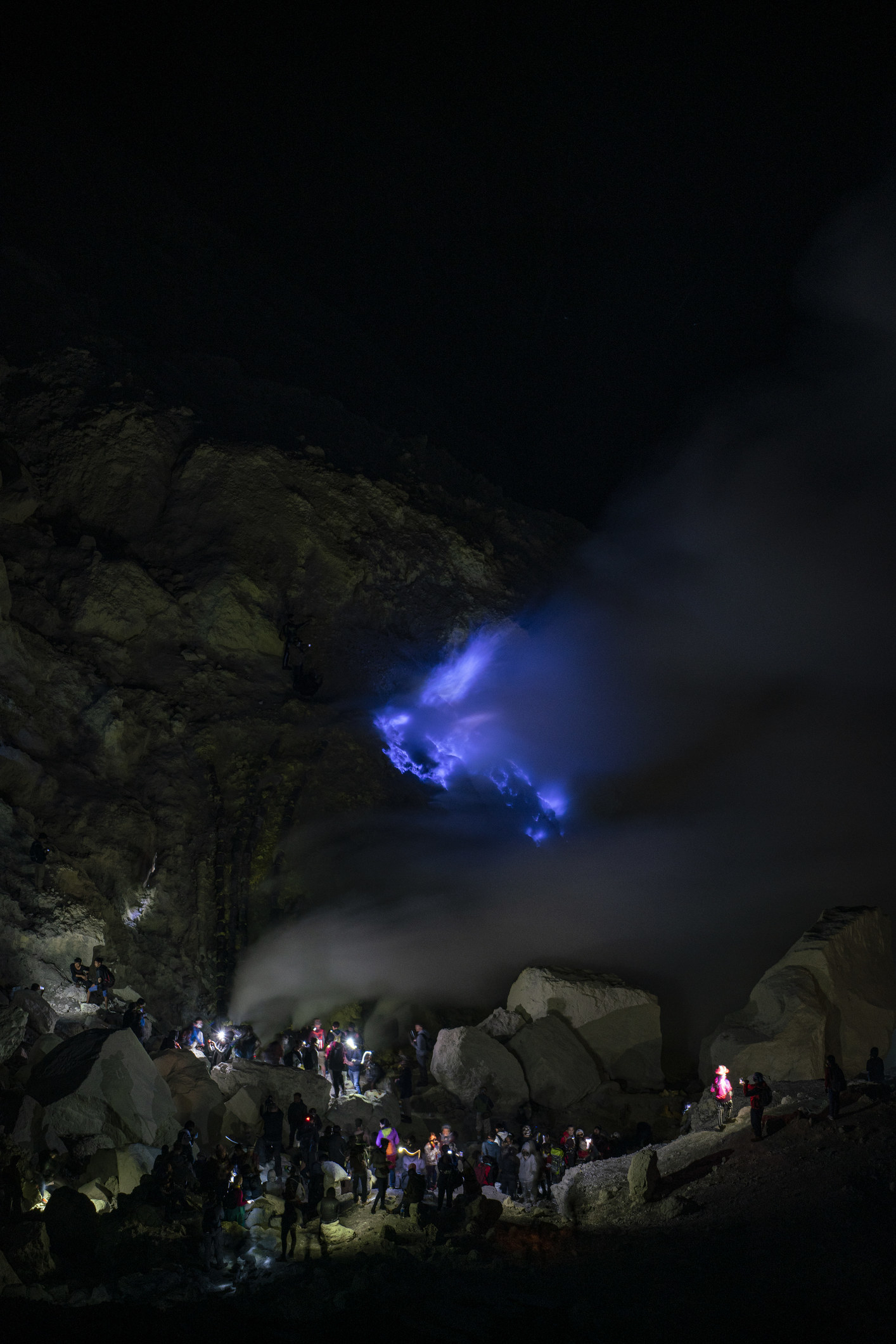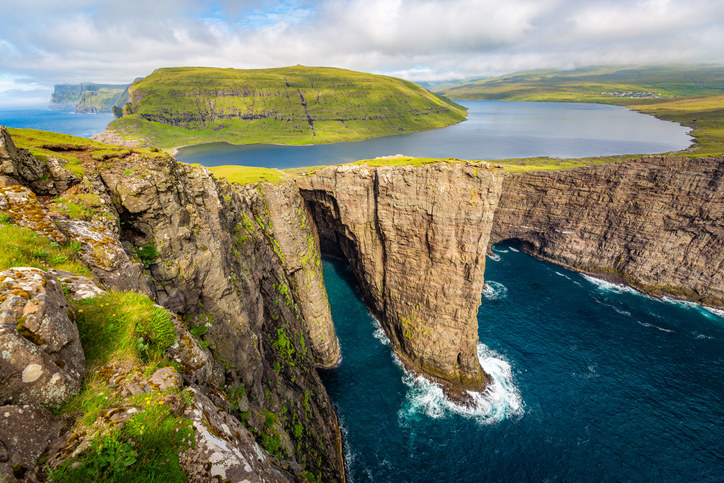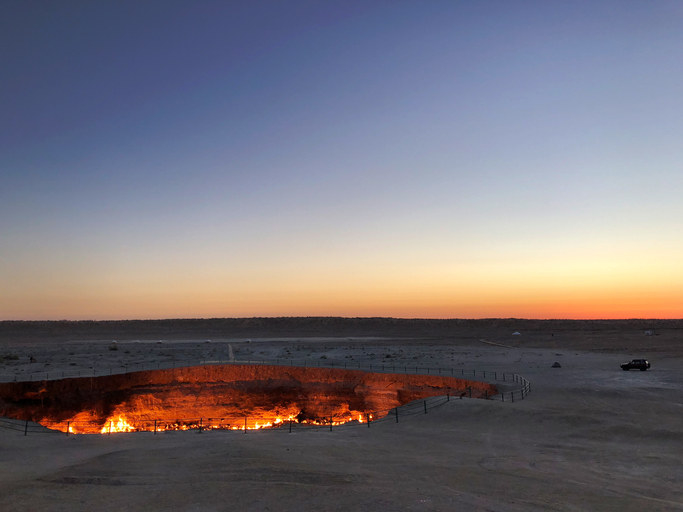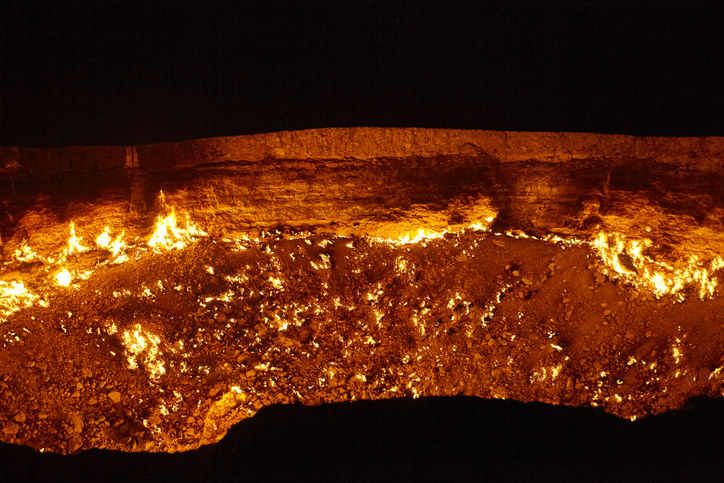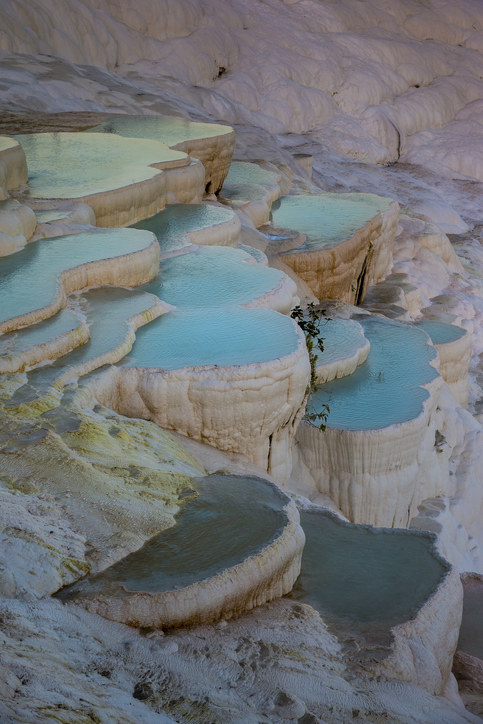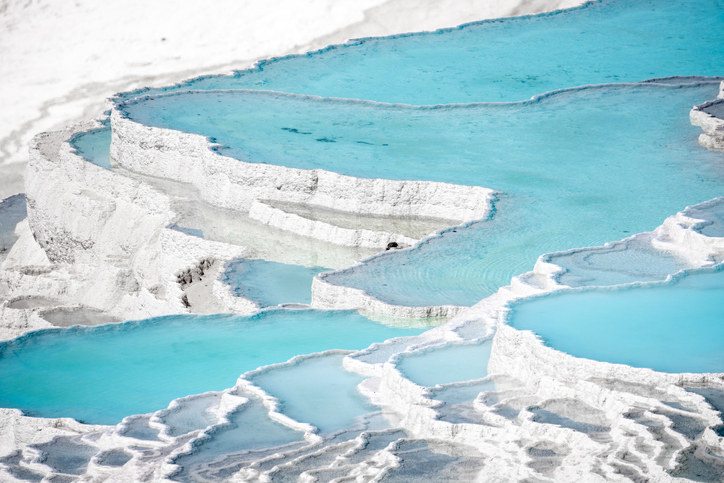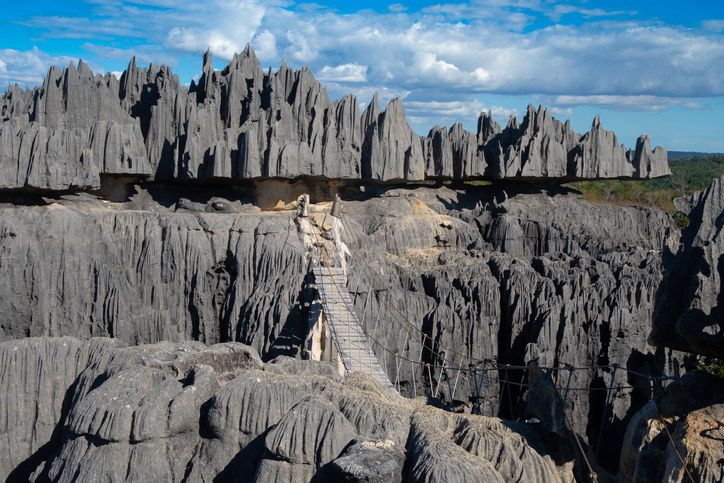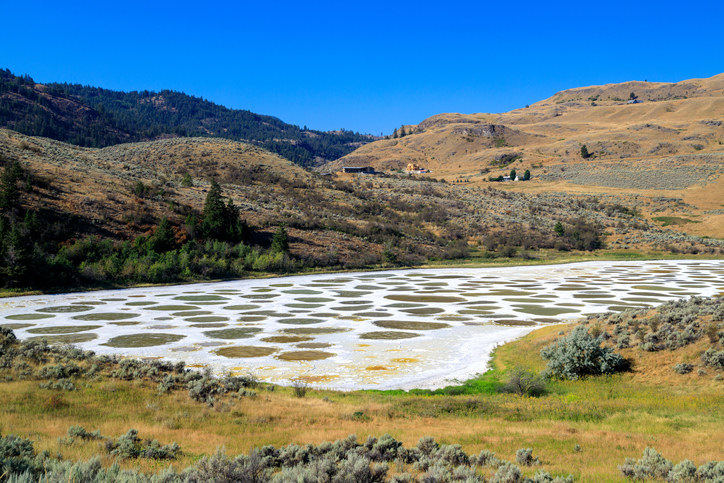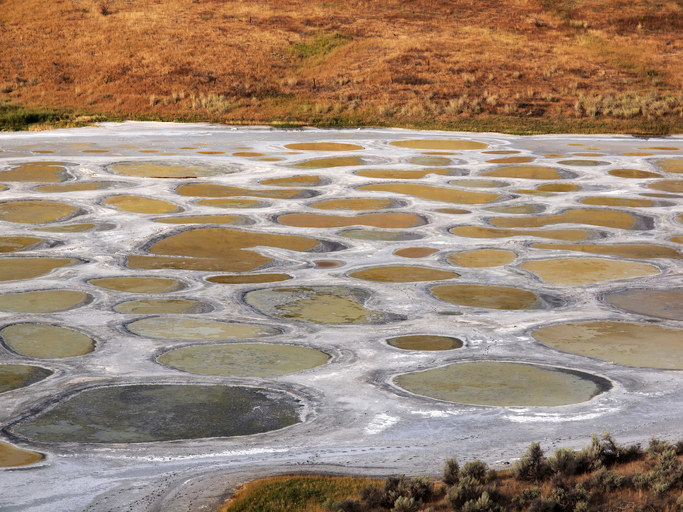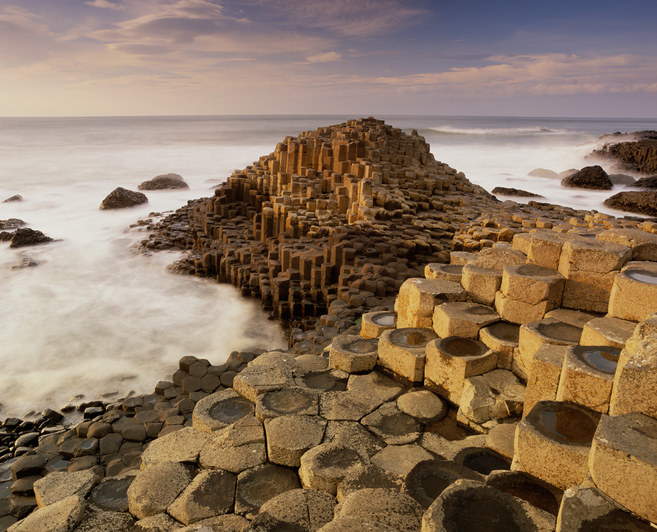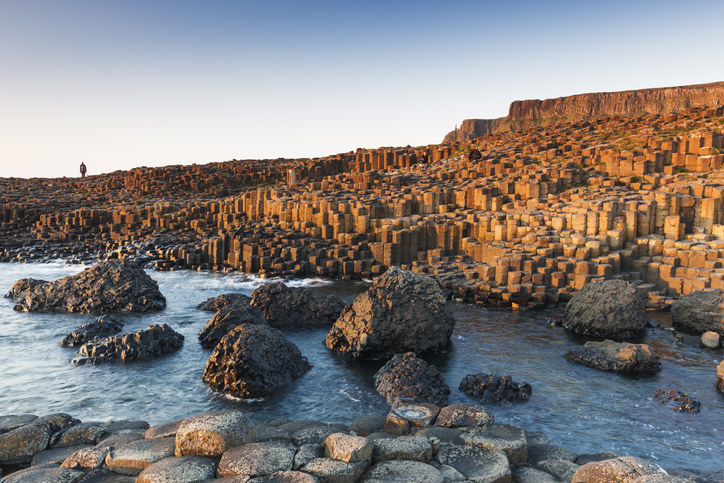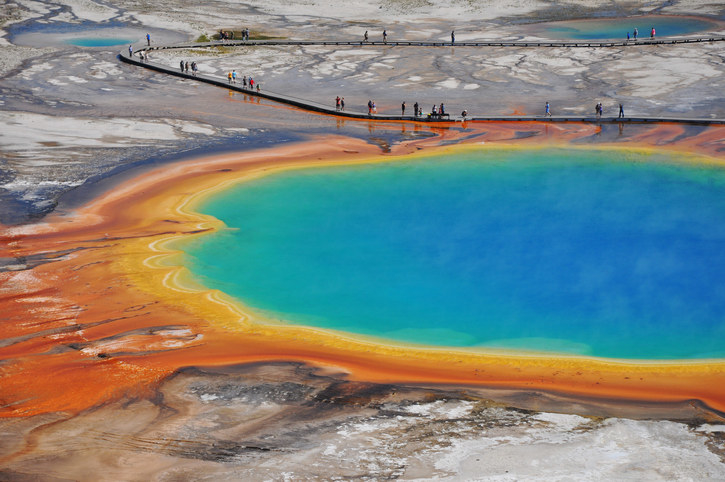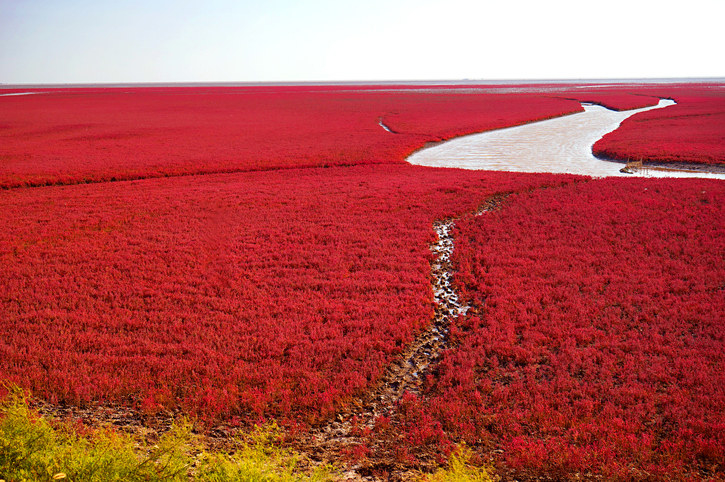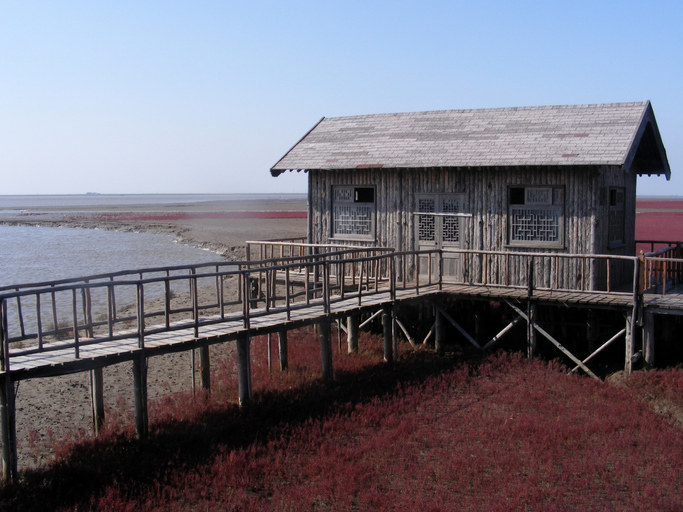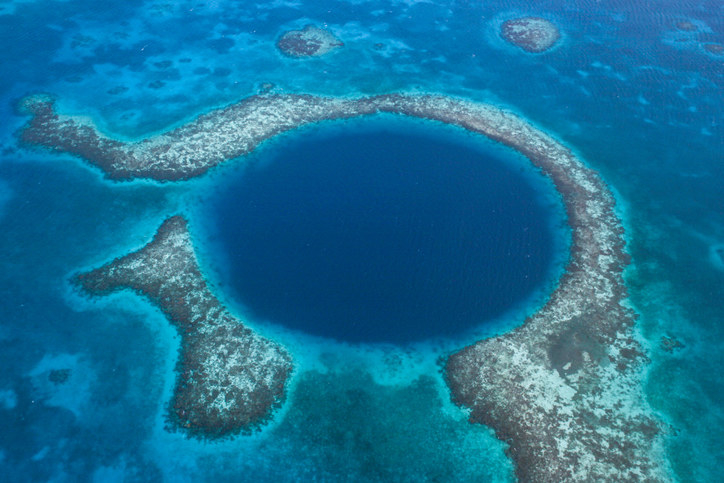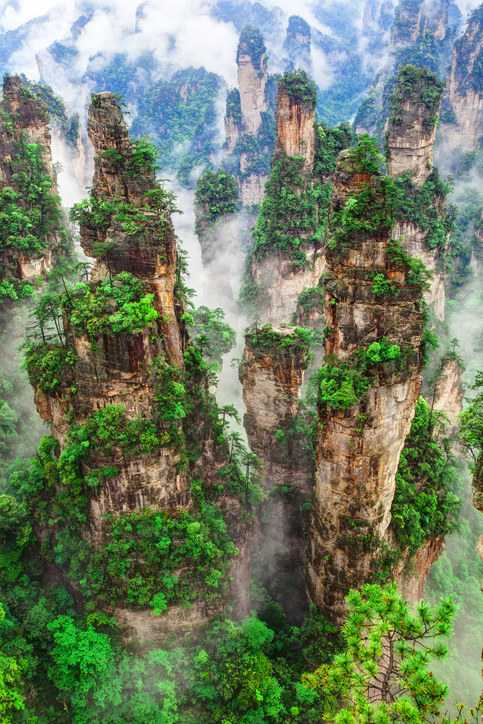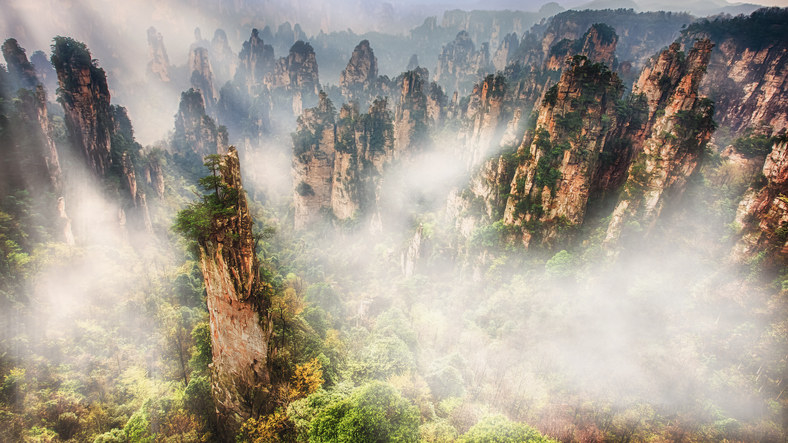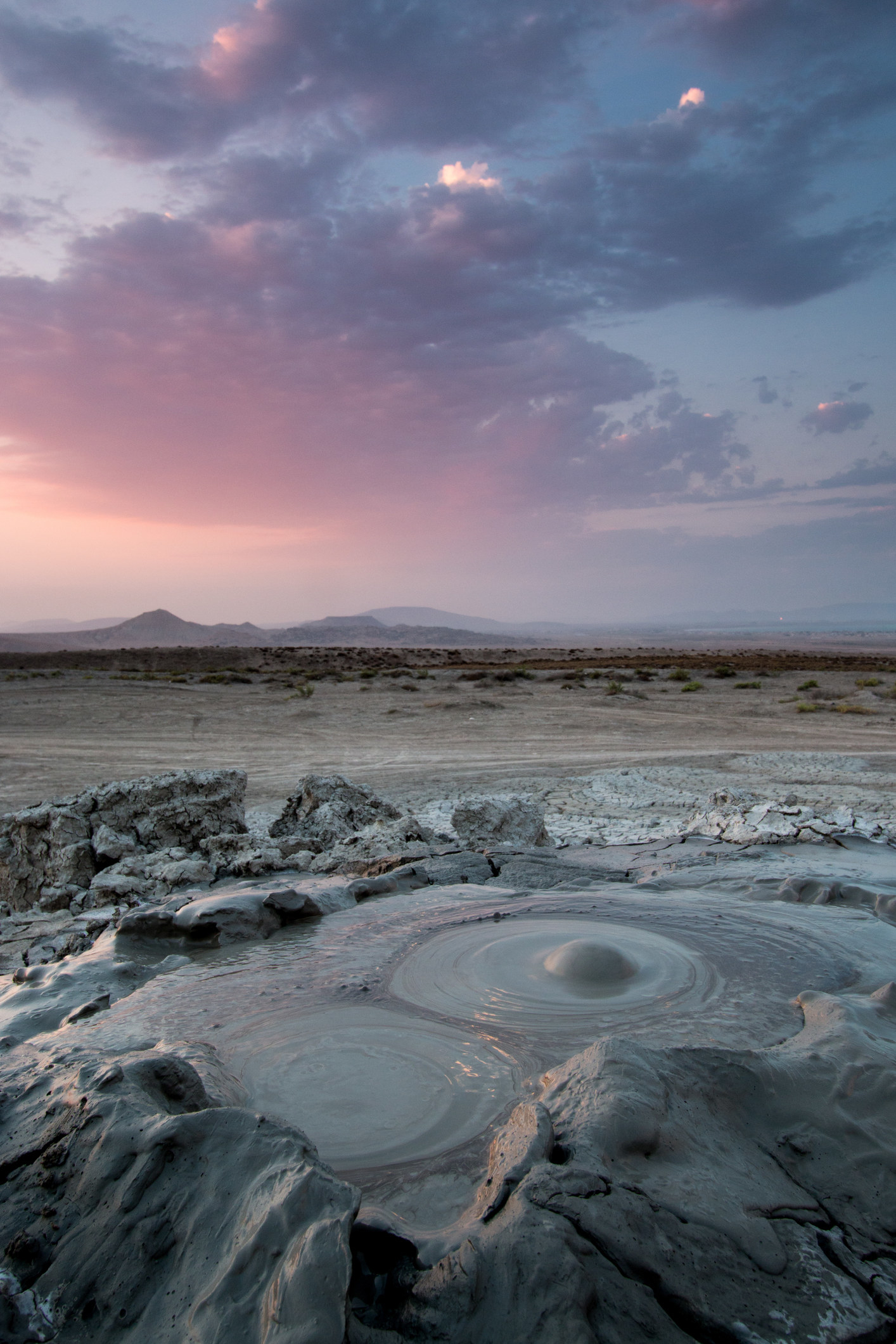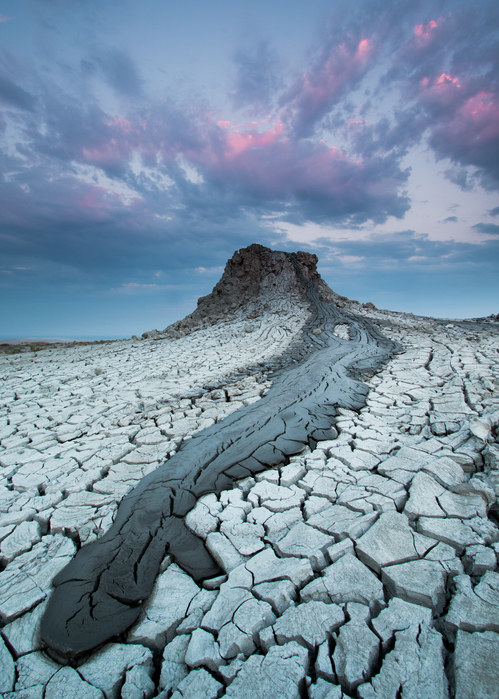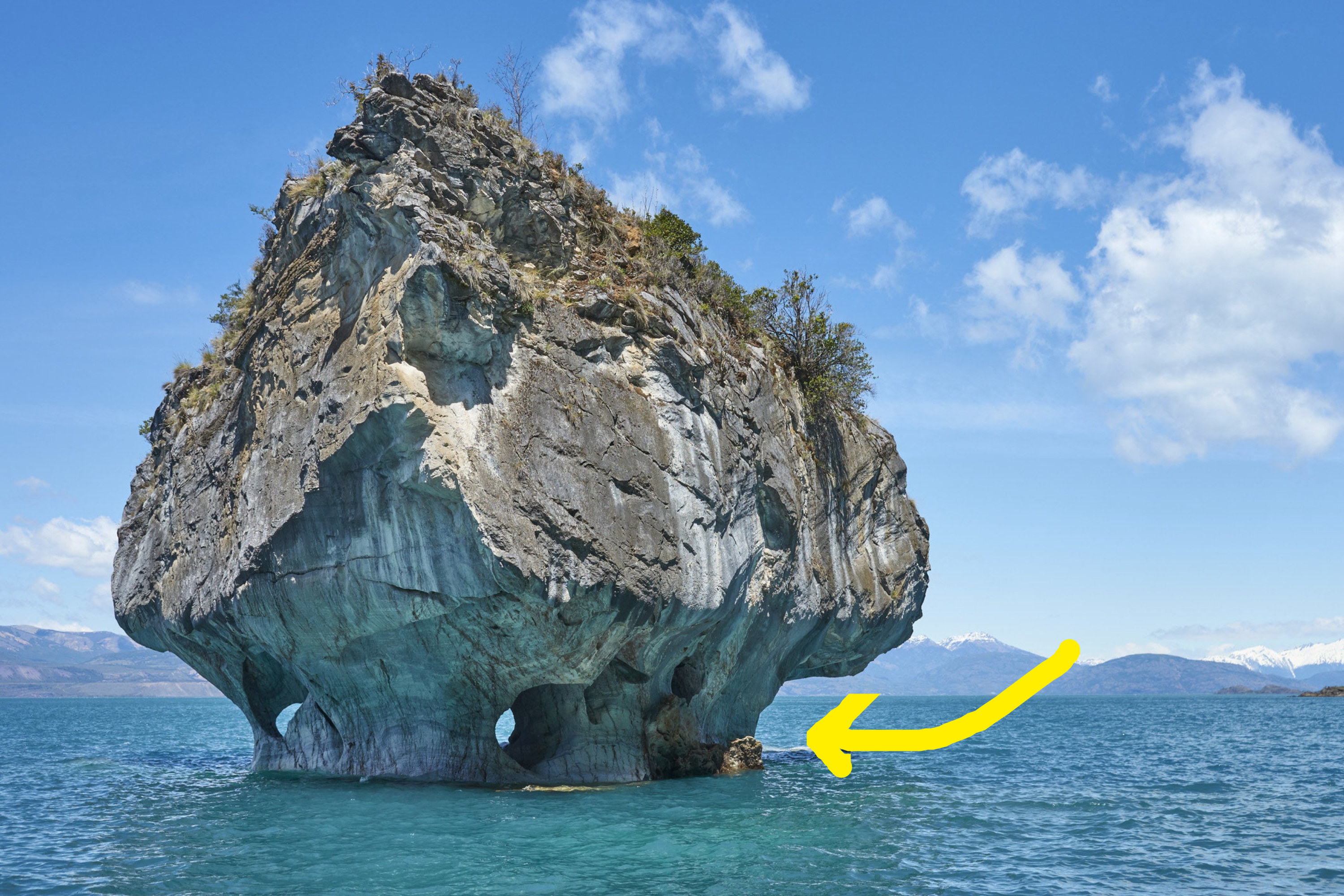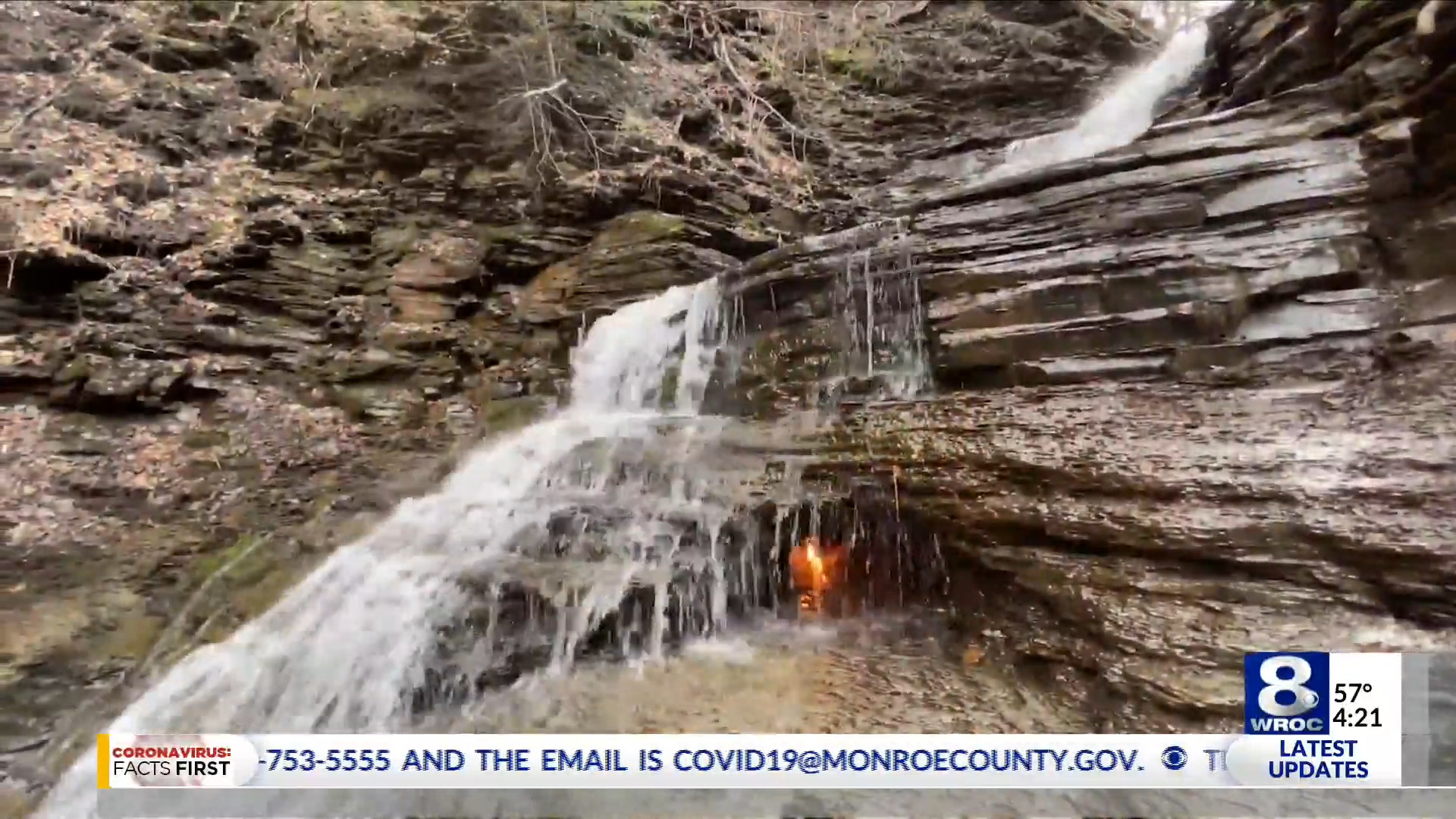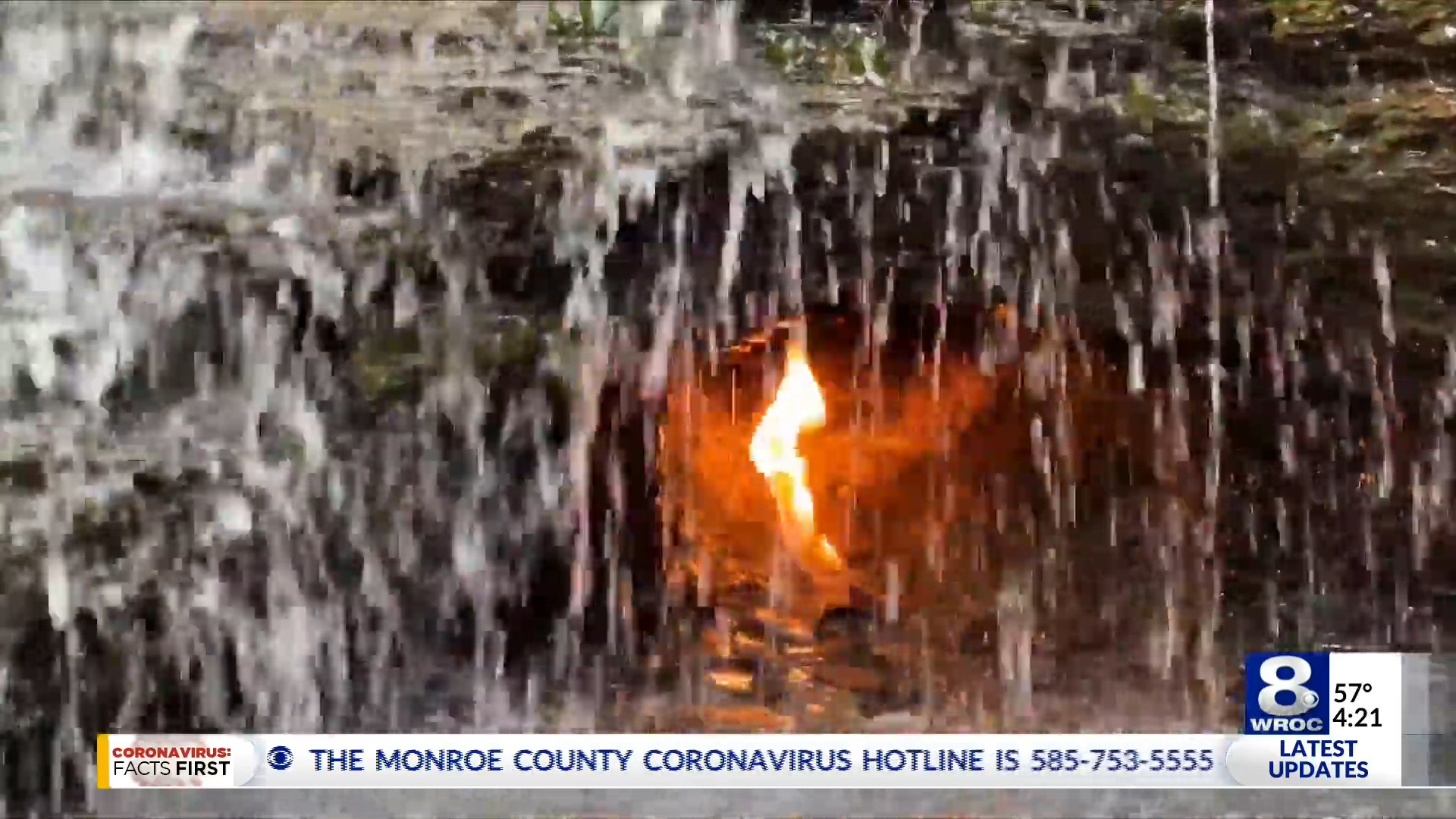1.
The "Salar de Uyuni," or the Uyuni Salt Flat, in Uyuni, Bolivia
The Uyuni Salt Flat is so expansive, it's actually the world's largest salt flat. For part of the year, the flat looks like the image below, with its floor covered in salt. During the rainy season, though, the flat essentially turns into a giant puddle, giving it the mirror effect as seen in the first image and making it look like you're walking on the clouds.
2.
Lake Hillier in Middle Island, Australia
The Western Australian lake's naturally Pepto Bismol-pink color still stumps scientists to this day. They theorize it's a result of either Dunaliella salina microalgae or halophilic bacteria in the lake's salt crusts.
3.
Waitomo Caves in New Zealand
The caves, which can be found under the hills of Waitomo, New Zealand, are home to underground rivers, sinkholes, and thousands of glowworms. The glowworm can only be found in New Zealand, and the large population of them in the caves is essentially mother nature's light show.
4.
Fly Ranch Geyser in Northern Nevada, USA
The creation of these geysers was kind of a happy accident. In 1916, locals drilled a well, but abandoned it because the water was too hot. Almost 50 years later, a geothermal power company drilled a test well in the same area, but failed to plug it properly when they left. Both those incidents lead to the formation of the geysers, which built themselves up as hot water shot up from the holes in the ground and calcium carbonate deposits formed the geysers.
5.
Lençóis Maranhenses National Park in Brazil
The park is home to thousands of these blue-green lagoons sandwiched between sand dunes. The dunes form in the dry season of the year, carried by the wind. The lagoons are made up of rainwater that has pooled in the valleys of the dunes during its wet season, so they can only be seen for a few months a year. When they are there, though, they can be as massive as 300 feet across and 10 feet deep.
Vinicunca means "colored mountain" in Quechua — a native Peruvian language. Its bright colors come from layers of 14 different minerals deposited on it. Shockingly, the mountain was only discovered in 2015, having previously been covered in snow.
7.
The Vatnajökull ice caves in Iceland
8.
Cueva de los Cristales, or The Cave of the Crystals, in Naica, Chihuahua, Mexico
The cave, a thousand feet under the Naica mountains, is home to some of the world's largest crystals. Like, I'm talking 36-foot-long crystals. This is all thanks to the cave's super high temperatures, high humidity, lack of light, and acidic air.
9.
Lake Natron in The Great Rift Valley, Tanzania
This vibrant red lake is the world's most caustic lake, which means it can corrode or destroy things that come in contact with it. Its bright color comes from the microorganisms — specifically, spirulina — that live in it. The lake isn't very welcoming to many beings, but flamingoes use it and the surrounding area as a nursery for their young.
10.
"The Sea of Stars" on Vaadhoo Island
Some beaches surrounding the Maldives — such as those on Vaadhoo Island — feature starry blue waves at night. The light actually comes from bioluminescent plankton, who shine when they hit the shore or when they're agitated in the water.
11.
The Kawah Ijen Acid Lake in Java, Indonesia
The turquoise-colored lake is located inside the crater of the Kawah Ijen volcano. Its bright color is a result of materials dissolved in the water, like hydrochloric and sulfuric acids.
12.
The Kawah Ijen Volcano in Java, Indonesia
Now that we've discussed the lake, let's talk about the volcano itself. When the Kawah Ijen Volcano erupts, it's surrounded by these deep, blue flames. This is a result of the veryyyy large amounts of sulfuric acid that emerge with the lava. There's so much sulfur, in fact, that when the fire burns at night, it flows down the volcano, making it appear as though the lava is bright blue.
The lake got this nickname because — from certain angles — the lake looks like it's actually hovering over the ocean. There's a waterfall — Bøsdalafossur — at the end of it, which leads into the Atlantic Ocean.
14.
The Darvaza gas crater, aka "The Gates Of Hell," in Turkmenistan
While it might look like a portal to the underworld, it's actually a natural gas field that's been constantly ablaze since the ground collapsed during a gas drilling expedition in the '70s. It's reported that scientists lit it on fire to prevent the gas from spreading, and the flames have never gone out.
15.
The Pamukkale thermal pools in the ancient city of Hierapolis, Turkey
The name Pamukkale translates to "cotton castle," but these pools and shelves formed from hardened calcium deposits certainly aren't as soft as they might look.
16.
The Tsingy de Bemaraha National Park in Western Madagascar
The park is named after these pointy spires called "tsingy." The strange shapes formed from a combination of monsoons and collapsed underground caves. Their pointed edges have given them the nickname the "forest of needles."
17.
Spotted Lake in the Okanagan Valley, British Columbia
The lake got its name for having these giant blue, green, and yellow circles during the summer. Surprisingly, it looks like your normal, run-of-the-mill lake during the winter and spring seasons. Once it gets hot, though, the lake water begins to evaporate and reveal the circular pattern under its surface. The pools are different colors because they are made up of different minerals and salts brought down as run-off from the nearby hills.
18.
The Giant's Causeway in Northern Ireland
The Causeway got its name from a legend that these 40,000-ish, hexagonal-shaped stones were made as stepping stones by the giant Fionn mac Cumhaill to reach Scotland. Fionn and another giant — Scottish giant Benandonner — did not get along, and so, Benandonner ripped the pathway apart into what the Giant's Causeway looks like today. Scientists believe these black basalt columns were created almost 60 million years ago, as a result of volcanic activity in the region.
19.
The Grand Prismatic Hot Spring at Yellowstone's Midway Geyser Basin
It's not only brightly colored and piping hot, but also the third largest spring in the whole world. The bright orange, yellow, and green colors come from various heat-loving bacteria that live in the cooler parts of the hot spring.
20.
The Red Beach in Panjin, China
Every fall, the wetlands along the Liaohe River turn a vibrant red. It's color is thanks to the high volume of seepweed in the area and the region's alkaline-heavy soil. As seen in the image below, the seepweed starts as a duller red, getting deeper throughout the summer and ultimately turning purple in the fall, before dying.
Located off the coast of Belize, it's a massive, underwater sinkhole in the Caribbean Sea. It measures over 984 feet wide and 410 feet deep, making it particularly popular for SCUBA divers. You can read a firsthand account from one of those divers here.
22.
Zhangjiajie National Forest Park
The park boasts these unique, pillar-like rock formations made of quartz-sandstone and shaped by rain.
23.
The Gobustan Mud Volcanoes in Azerbaijan
The craters of many of these volcanoes are filled with bubbly mud breccia. This is a result of methane gas pushing its way to the volcano's surface, and mixing the thick clay with water and oil. They're small and not filled with lava-like regular volcanoes, so the mud stays around 72ºF.
24.
Cavernas de Mármol, or "The Marble Caves" in Chile
The caves, located in General Carrera Lake, are made up of huge, eroded marble deposits, now just above water level.
25.
And finally, Eternal Flame Falls in Orchard Park, New York, USA
Eternal Flame Falls is a 35-foot waterfall with a small, never-ending flame blazing in one of its grottos. The flame is believed to be fueled by a continuous gas from a pocket, though scientists are uncertain how the gas itself is being created.
Do you know of any other places in the world that are so wild, you almost can't believe they exist on the same planet as you? If so, tell us about them in the comments below!

